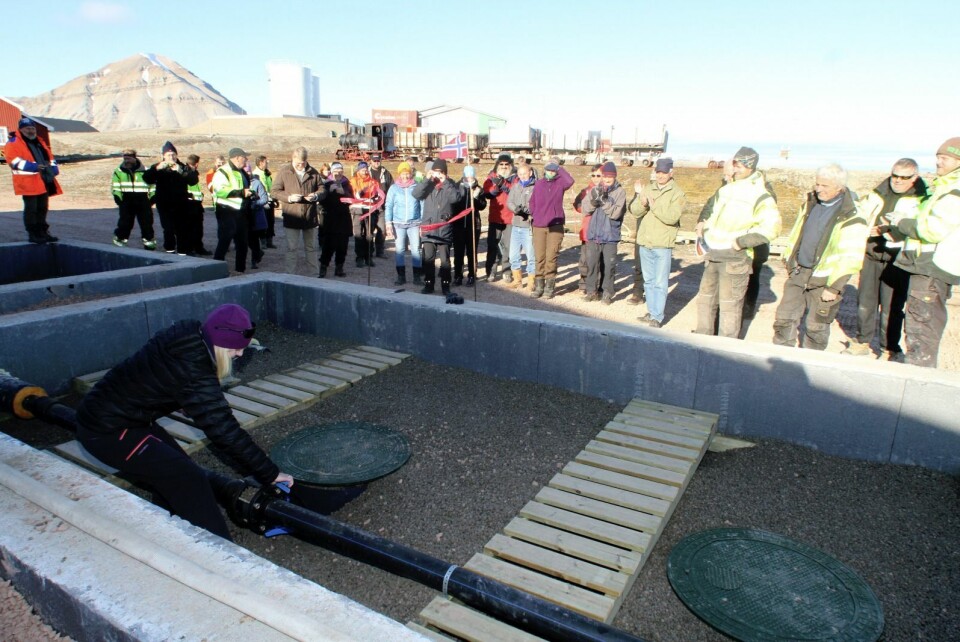Spending millions for the environment
Kings Bay has spent more than 12 million kroner on environmental measures in Ny-Ålesund since 2013. Now a sewage treatment plant is helping keep the sea clean.

Denne artikkelen er mer enn fem år gammel.
The ribbon was cut at 11 a.m. Wednesday, marking the official start of Svalbard's first major sewage treatment plant. The debut marks the end of discharges into Kongsfjorden, which is used as a marine laboratory with sensitive equipment. Although the quantity of discharges is relatively small, the facility is about principles, said Ole Øiseth, administrative director of Kings Bay AS.
"The sewage was going straight into the fjord," he said. "As a research spot, we cannot be proud with dropping sewage straight into the fjord. We have the ability to collect it because it all goes out in one drain, so it was no problem running it through the system."
On Wednesday was visited by the Kings Bay board of directors in Kings Bay for their annual inspection. Accompanying them was Thorunn Bakke, deputy director of the Ministry of Trade, Industry and Fisheries, who as a representative of the station's owner declared the northernmost sewage treatment plant open.
"For a research community, such a facility is appropriate and important," she said.
For 200
The plant cost about 1.5 million kroner and has a capacity of 10,000 liters a day. Kings Bay as a host provides infrastructure for researchers and other visitors from all over the world. The amount of activity varies according to the seasons, with 123 people currently in Ny-Ålesund. Peak season ends in late September and the population decreases until it rises again in March of next year.
A maximum of 200 people live in the community, which is the capacity the sewage plant is designed for, Øiseth. said. A separate treatment plant has long been a topic of discussion and its development was seen as necessary.
"The sewage plant has been on the agenda and it has been my intention to implement a sewage treatment plant," he said. "I have thought that for as long I've been here and we began preparations last fall."
Challenges
With the exception of a smaller and older plant at the Polish research station in Hornsund, this is the first sewage treatment plant on Svalbard under the auspices of Norway. And it's definitely the most northerly.
"It's kind of neat to get an order so far up," said Bjørn Stiansen, a representative for Klaro, a company that builds treatment plants in Scandinvia. "Now there will be some small adjustments."
"It is clear that it is a bit more challenging up here because of the cold, but we have insulation," he said. "What is special here is that we have made a slurry system where we can pump out the sludge and make compost."
The treatment plant is in a container, but discreetly located inside the old iron warehouse.
Reducing consumption
This is one of several environmental- and energy-saving measures implemented in Ny-Ålesund in recent years.
Between 12 million and 15 million kroner has been spent since 2013 on projects to reduce consumption and emissions, according to Kings Bay.
Pipelines previously heated by electricity are now heated by glycolic means in a closed system. A computer now monitors control of heating and ventilation in buildings after they were insulated.
The efforts have resulted in a reduction of diesel at the power plant of about 200,000 liters.
"Purification of emissions from the power station remains and that is something Kings Bay will now examine in cooperation with, among others, Sintef," Øiseth said.
"It is stipulated that we will be as green as possible," he said. "So therefore that is this one of the most specific measures we can do."
A new building is also under construction to increase the garage capacity in Ny-Ålesund. The building is 37-by-17 meters and has a conference hall on the second floor. The plan is to open the conference hall during the Ny-Ålesund Symposium in May of next year, when experts from around the world gather to discuss climate change.
Translated by Mark Sabbatini
